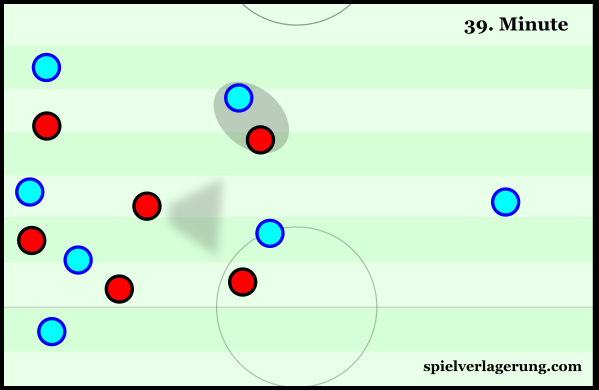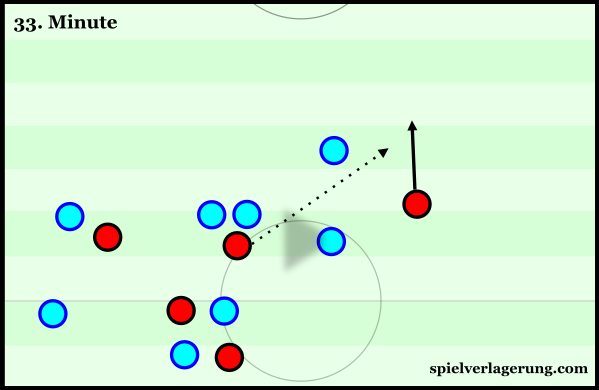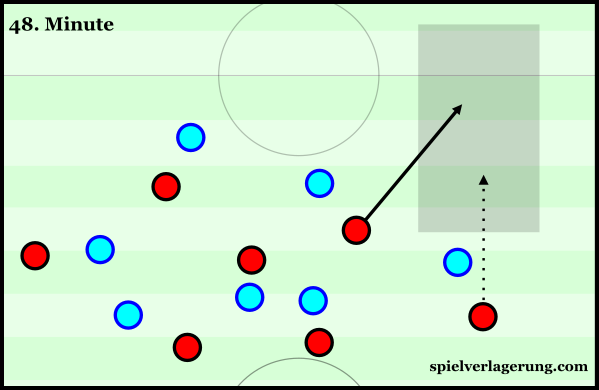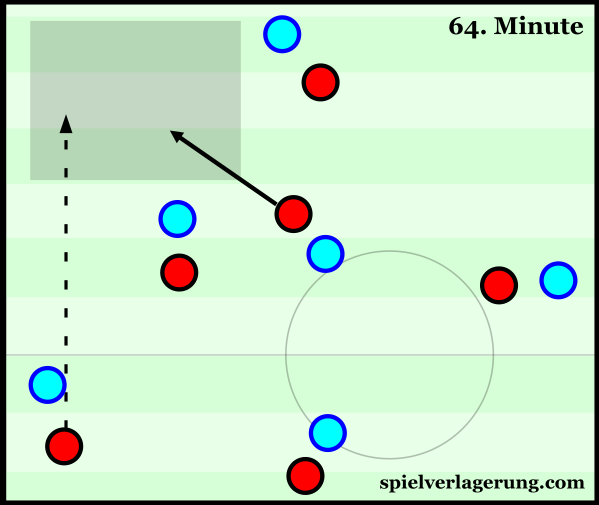Liverpool assert dominance after uncertain start
Jürgen Klopp’s Liverpool played host to Stoke City in the sole Premier League fixture on bank holiday Tuesday. Stoke arrived at Anfield in relatively poor form, without a win in their previous three matches. On the other hand, Liverpool came into the game fresh from a hotly contested victory in the Merseyside derby, giving them local bragging rights as well as back to back wins after a small blip in form at the start of the month.
 Stoke’s strong start
Stoke’s strong start
Stoke’s attacking strategy was very effective over the opening 20 minutes of the game, generating two good chances as well as several moments of confusion and disorganisation within the Liverpool defence. Their main plan of attack was to try and find Peter Crouch with a long, high pass and then rely on him to retain the ball and bring others into the fold. Moreover, they looked to get players (particularly Jonathan Walters) close to Crouch in an effort to try and retain the ball should the initial long pass be heavily contested or escape the control of Crouch.
This caused a number of problems for Liverpool, as the direct nature of Stoke’s attacking strategy meant that their ability to press and force turnovers of possession was limited due to the Stoke defenders looking to play long at every opportunity. This was a good decision by Mark Hughes as it took away a key part of Liverpool’s game whilst minimising the exposure of his centre-backs rather poor ability to play through pressure.
In addition, the long balls aimed at Crouch often caused the Liverpool defence to collapse around his position. This created lots of space for the Stoke attackers to use, should they be able to retain the ball and find the free player who was most often in a wide area.
The clearest example of this strategy can be seen in the build-up to the opening goal. Whilst the long goal kick does not reach Crouch immediately, Walters is able to win his header and get the ball to his strike partner. From this, Liverpool collapse to press Crouch who is able to play a simple pass back to Joe Allen to escape the pressure and allow his team mate to receive the ball with a forward facing view.
Unfortunately for the away side, this attacking approach was not sustainable over the course of the game. The accuracy of the passes towards Crouch as well as his ability to keep hold of the ball dwindled as the first half went on. This meant that Liverpool were able to generate considerable attacking pressure due to regaining the ball more frequently and closer to the Stoke goal.
It should also be noted that Liverpool afforded the Stoke defenders far less time on the ball as the half progressed. They were also quicker to apply pressure to all ball carriers as well as being more coordinated and effective at preventing their ability to play backwards or to the other side of the pitch. This meant that Stoke defenders and midfielders were often starved of options and forced to play within a much smaller area of the pitch. As a result of this, Liverpool often trapped Stoke against the touchline or in wide areas forcing easy ball recoveries and then tried to transition quickly into the spaces left by the Stoke players attempting to take up attacking positions.
Liverpool’s early struggle against Stoke’s man-to-man marking
Stoke positioned themselves in 3-5-2 shape when defending and opted for a passive man-to-man approach in picking up the Liverpool players. As a result of this, when Liverpool had the ball in early build-up, Stoke adopted a 3-4-3 with Allen joining Walters and Crouch in the first defensive line. This meant that they were effectively able to match Liverpool’s attacking positional structure right across the pitch. With Sadio Mané and Roberto Firmino wanting to move inside and try to combine through the half-spaces, it was easy for the wider of Stoke’s three centre-backs to pick them up.
The effect of this was that Liverpool initially struggled to generate free players in between Stoke’s lines of defence as they would be tightly followed by their marker. Both Glen Johnson and Bruno Martins Indi would leave the defensive line in order to track Firmino and Mané should they drop deep to try and overload the midfield area. This was far more frequent with Firmino as he looked to aid his midfielders in creating chances whilst Mané was focused more on trying to move behind the midfield instead.
Furthermore, when the ball was with Simon Mignolet, the three Stoke players in the first line would prefer to stick tightly to Jordan Henderson and the centre-backs rather than try to press the goalkeeper. A recurring scene in the opening exchanges was Liverpool attempting to build play using Mignolet rather fruitlessly. With his immediate options covered, he was forced to try and either find the full-backs positioned high and wide or look to play a longer pass for Divock Origi to try and outmuscle Ryan Shawcross. Needless to say, this wasn’t particularly effective and as a result Liverpool looked rather toothless for the opening half hour.
Manipulation of marking sees Liverpool overturn the deficit
The role of Sadio Mané altered slightly after around thirty minutes. Instead of looking to move inside and try to receive the ball in front of the Stoke defence he began to hold his position slightly outside of the defensive block in order to try and generate opportunities to exploit his superior pace and dribbling skills one on one against a Stoke defender. This strategy can be seen in the build-up to Liverpool’s equaliser as instead of looking to move inside and combine with Origi, he spots that Erik Pieters is very narrow and waits on the blindside of the defender to receive the ball from Origi. With plenty of space to run into, as well as drawing a central defender away from his team mates into a promising one on one scenario, Mané is able to create space for the onrushing Adam Lallana to score.
After the equalising goal Liverpool began to look more dangerous. The primary reason for this was their intelligent use of player movement to manipulate the marking of Stoke’s wing backs in order to create space both out wide and in the half-spaces behind the midfield. This was most often achieved when James Milner and Nathaniel Clyne remained in conservative positions in early build-up, forcing the Stoke wing backs to challenge them much higher up the pitch than they would have during the opening exchanges. By doing this, it allowed a Liverpool midfielder to receive the ball free from pressure behind the first line of Stoke’s defence with space to dribble and assess passing options.
Liverpool used this method of attracting wing backs higher up the pitch in combination with attackers dropping deep to further disrupt the Stoke defence. Origi and Firmino in particular would look to drop deep to receive the ball in midfield. Whilst this isn’t too dissimilar to what they did during the stale opening exchanges the movement of Georginio Wijnaldum and Lallana is what made this method of attack more effective. As the forwards dropped, they would make diagonal runs to attack the space vacated by the defenders who followed either Origi or Firmino. The Stoke midfielders could not track these runs without completely opening up the centre of the field for Liverpool to attack through. This moment of indecision is all that is required for the midfielders to become free men and disrupt the man-marking scheme as another player must then leave his assignment to maintain access to the ball. This has the potential to become a chain of players become free from their markers due to defenders scrambling to try and reorganise their marking whilst preventing Liverpool from advancing into dangerous areas.
Conclusion
After a strong opening where they controlled the second balls well, Stoke ultimately faded as the game went on and the accuracy of their long passes faltered due to an increasingly effective Liverpool press. Once Liverpool were able to regain their composure after falling behind they were consistently able to manipulate Stoke’s man-marking in order to generate free players between the lines as well as imbalances in their overall structure.
The result means three victories in a row for Klopp’s Liverpool as they move above Manchester City into second place ahead of their eagerly anticipated encounter at Anfield on New Year’s Eve. On the other hand, Stoke are now without a win in four but still sit comfortably in mid-table.
Daniel Bower usually writes for City Watch. Follow him on Twitter @Unnamed_TBD.








Keine Kommentare vorhanden Alle anzeigen